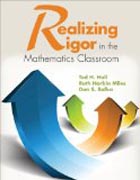
Realizing Rigor in the Mathematics Classroom
Hull, Ted H. (Henry)
Miles, Ruth Ella Harbin
Balka, Don S.
Rigor: The Common Core has made it policy—and this first-of-its-kind guide takes math teachers and leaders through the process of making it reality. Using the Proficiency Matrix as a framework, the authors offer proven strategies and practical tools for successful implementation of the CCSS mathematical practices—with rigor as a central objective. Readers learn how to Define rigor in the context of each mathematical practice Identify and overcome potential issues, including differentiating instruction and using data Relate specific roles and goals for all stakeholders Use assessment tools to guide work and monitor progress Using the Proficiency Matrix framework along with practical assessment tools, math teachers and leaders will define and achieve rigor in the context of the CCSS mathematical practices. INDICE: Foreword by Suzanne MitchellIntroduction CCSS Content and Practice: Opportunity for Rigor A Clue to Rigor Outline of the Book How to Use This BookPart I. The Foundation1. Understanding and Meeting the Challenge of Rigor National Assessments Teacher Evaluation Learning Shifts Meeting the Challenges Looking at Assessments Rigor as a Common Factor2. Defining and Instituting Rigor Searching for Evidence Dictionary and Thesaurus Professional Opinions Indicators of Rigor Drawing Conclusions Decision Point Contrasting Example Lessons Problem Analysis Transforming Classrooms to Support Rigor Having Productive Conversations3. Building Team Leadership to Support Rigor Role of a Steering Committee Role of a Leadership Team Role of the Principal Developing Learning Communities A Principal's Story Having Productive Conversations4. Rigor and the Standards for Practice Rigor and Practices A Principal's Story Having Productive Conversations5. Rigor Related to Classroom Formative Assessment Assessment Types Classroom Formative Assessment Refining Formative Assessment Classroom Formative Assessment Formative Assessment and Intervention Current Learning Effective Intervention Instructional Research Synergy A Principal's Story Having Productive Conversations6. Rigor and the Proficiency Matrix Organization Progress Toward Rigor Strategy Relationship in the Matrix Classroom Formative Assessment and the Matrix Ms. Edward's Classroom A Principal's Story Having Productive ConversationsPart II. Issues and Obstacles7. Issues to Resolve Issue: Teaching the Identified Content Issue: Deepening Mathematical Understandings Issue: Reaching All Students8. Obstacles to Success Obstacle: Working in Isolation Obstacle: Attempting to Evaluate People to Change Obstacle: Failing to Monitor Student Actions Obstacle: Over Adoption Obstacle: Mistaken Efforts Understanding MAAT Having Productive ConversationsPart III. Solutions9. Solution Step One: Monitoring Student Actions Related to the Practices Opening Classroom Doors Non-Evaluative Monitoring Starting With Students Teacher Self-Assessment of Student Actions Scenario Having Productive Conversations10. Solution Step Two: Using Classroom Visit Data-Assessment of Student Actions Conducting Productive Conversations Understanding Change Process Levels of Adoption Intervention as Support Building a Critical Mass Changing the Culture Connecting Actions Chart Having Productive Conversations11. Solution Step Three: Monitoring Teacher Actions Related to the Practices Using the Classroom Visit Tally - Teachers Conversations About the Data Working on Individual Needs Mathematics Collaborative Log Teacher Planning Guide Having Productive Conversations12. Solution Step Four: Gathering and Using Additional Data Assessments Collectively Specified Classroom Visits Validity Visits Reverse Visits Teacher Requested Visits Supporting Teachers' Change Efforts Adoption Stages Documenting Progress Completing the Form Having Productive Conversations13. Solution Step Five: Maintaining Progress Toward Rigor Background Relating Mathematical Rigor and the Practices Inferences from the Standards for Mathematical Practices Rigor as an Outcome Categories Rigor Analysis Form Explanation Directions Guiding the Work Input and Outcomes Having Productive ConversationsPart IV. Inputs and Outcomes14. Teaching for Rigor Inputs Outcomes Teaching for Progress in Rigor Having Productive Conversations15. Coaching for Rigor Inputs Outcomes Coaching for Progress in Rigor Having Productive Conversations16. Leading for Rigor Inputs Outcomes Leading for Progress in Rigor Having Productive ConversationsPart V. Momentum17. Linking Responsibilities - Assessing Progress Professional Trust Professional Conversations Supporting Teacher Change Documenting Change Conclusion Having Productive ConversationsReferencesIndex
- ISBN: 978-1-4522-9960-0
- Editorial: Corwin
- Encuadernacion: Rústica
- Páginas: 192
- Fecha Publicación: 30/04/2014
- Nº Volúmenes: 1
- Idioma:
